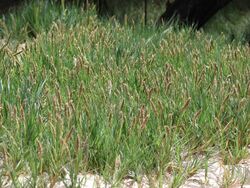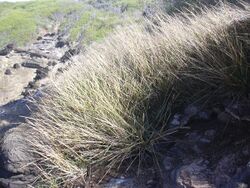Biology:Sporobolus
| Sporobolus | |
|---|---|

| |
| Sporobolus virginicus | |
| Scientific classification | |
| Kingdom: | Plantae |
| Clade: | Tracheophytes |
| Clade: | Angiosperms |
| Clade: | Monocots |
| Clade: | Commelinids |
| Order: | Poales |
| Family: | Poaceae |
| Subfamily: | Chloridoideae |
| Tribe: | Zoysieae |
| Subtribe: | Sporobolinae |
| Genus: | Sporobolus R.Br.[1] |
| Type species | |
| Sporobolus indicus | |
| Synonyms[4] | |
| |
Sporobolus is a nearly cosmopolitan genus of plants in the grass family.[5][3][6][7][8] The name Sporobolus means "seed-thrower", and is derived from Ancient Greek word σπόρος (spóros), meaning "seed", and the root of βάλλειν (bállein) "to throw", referring to the dispersion of seeds.[9] Members of the genus are usually called dropseeds[10] or sacaton grasses. They are typical prairie and savanna plants, occurring in other types of open habitat in warmer climates. At least one species (S. caespitosus from Saint Helena) is threatened with extinction, and another (S. durus from Ascension Island) is extinct.
Uses
While some dropseeds, such as prairie dropseed (Sporobolus heterolepis), make nice gardening plants,[11] they are generally considered[who?] to make inferior pastures,[citation needed] but seeds of at least some species are edible and nutritious; they were used as food, for example, by the Chiricahua Apaches. Other species are reported to be used as famine foods, such as Sporobolus indicus in parts of the Oromia Region of Ethiopia, where it is known as muriy in Oromiffa.[12]
Known as popote de cambray, Sporobolus grasses are used in popotillo art or straw mosaics, a Mexican folk art with pre-Columbian origins.[13]
The 1889 book The Useful Native Plants of Australia records that Sporobolus actinocladus is a "Perennial; seeds in October and November. A much esteemed pasture grass of the back country, common on rich loamy soil; stock of all kinds are very fond of it."[14]
Ecology
Caterpillars of the small moth Bucculatrix sporobolella have only been found on alkali sacaton (Sporobolus airoides). The Laysan dropseed noctuid moth (Hypena laysanensis) on Laysan Island apparently became extinct with the local eradication of S. virginicus by feral rabbits. Seed-eating birds including American sparrows (genus Aimophila) feed on sacaton seeds. S. wrightii is a critical resource for Botteri's sparrow (Aimophila botterii) which at one time was extirpated from Arizona.
Selected species
About 160 species are placed in the genus, including:[15][4]
This list does not include numerous species moved from other genera to Sporobolus after a 2014 taxonomic revision, including species in Crypsis, Eragrostis, Thellungia, Calamovilfa, and Spartina.[16]
Numerous species have been moved from Sporobolus to other genera: Agrostis, Arctagrostis, Eragrostis, Mosdenia, Muhlenbergia, Poa, Sacciolepis, Thysanolaena, and Urochondra.[4]
References
- ↑ {{citation | mode = cs1 | title = Genus Sporobolus R. Br. | work = Germplasm Resources Information Network (GRIN) | url = | publisher = [[Organization:Agricultural Research ServAgricultural Research Service (ARS), United States Department of Agriculture (USDA) | access-date = 2011-02-28 }}
- ↑ lectotype designated by L.K.G. Pfeiffer, Nom. Bot. 2:1274 (1874)
- ↑ 3.0 3.1 "Sporobolus R. Br.", Tropicos, Missouri Botanical Garden, http://www.tropicos.org/NameSearch.aspx?projectid=&name=Sporobolus
- ↑ 4.0 4.1 4.2 [Expression error: Unexpected < operator. "Expression error: Unexpected < operator."]. World Checklist of Selected Plant Families (WCSP). Royal Botanic Gardens, Kew. Expression error: Unexpected < operator..
- ↑ Brown, Robert (1810) (in Latin). Prodromus florae Novae Hollandiae et Insulae Van-Diemen, exhibens characteres plantarum. 1. London: Richard Taylor. pp. 169-170. doi:10.5962/bhl.title.3678.
- ↑ Lua error: Internal error: The interpreter exited with status 1.
- ↑ "Genere Sporobolus". http://luirig.altervista.org/flora/taxa/floraspecie.php?genere=sporobolus. Includes photos and distribution maps for several species.
- ↑ "Sporobolus", County-level distribution maps from the North American Plant Atlas (NAPA) (Biota of North America Program (BONAP)), 2014, http://bonap.net/NAPA/TaxonMaps/Genus/County/Sporobolus
- ↑ Quattrocchi, Umberto (2000). CRC World Dictionary of Plant Names: Common Names, Scientific Names, Eponyms, Synonyms, and Etymology. IV R-Z. Taylor & Francis US. p. 2542. ISBN 978-0-8493-2678-3. https://books.google.com/books?id=zIOvJSJs-IkC.
- ↑ Lua error: Internal error: The interpreter exited with status 1.
- ↑ "Sporobolus heterolepis". Missouri Botanical Garden. http://www.missouribotanicalgarden.org/PlantFinder/PlantFinderDetails.aspx?kempercode=f680.
- ↑ Lemessa, Dechassa (November 1999). "Prosperity Fades: Jimma and Illubabor Zones of Oromiya Region". UN Emergency Unit for Ethiopia. http://www.africa.upenn.edu/eue_web/orom1099.htm.
- ↑ "Papel Picado, Papel Amate, and Popotillo". Festival of Mexico. http://www.festivalofmexico.com/paperarts.html.
- ↑ J. H. Maiden (1889). The useful native plants of Australia (including Tasmania). Sydney: Turner and Henderson. p. 108. doi:10.5962/bhl.title.12190. https://www.biodiversitylibrary.org/bibliography/12190.
- ↑ Lua error: Internal error: The interpreter exited with status 1.
- ↑ Peterson, Paul M.; Romaschenko, Konstantin; Herrera Arrieta, Y.; Saarela, J. M. (2014). "A molecular phylogeny and new subgeneric classification of Sporobolus (Poaceae: Chloridoideae: Sporobolinae)". Taxon 63 (6): 1212–1243. doi:10.12705/636.19.
Lua error: Internal error: The interpreter exited with status 1.
Wikidata ☰ Q2603825 entry
Lua error: Internal error: The interpreter exited with status 1.


